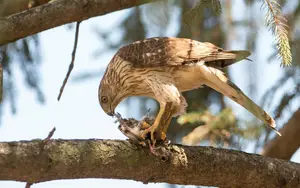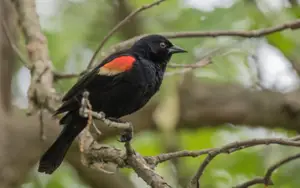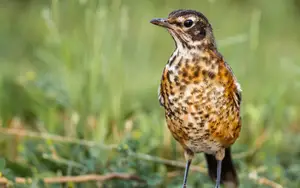12 Types Of HERONS In North Carolina (ID Guide With Photos)
Did you recently come across a heron in the state of North Carolina, and want to know what species it was?
Identifying herons in the Old North State is not as easy as it might seem, since there are many heron species in North Carolina (as well as closely related egret and bittern species).
To help you identify the bird you saw, we’ll cover the most common herons of North Carolina in this article.
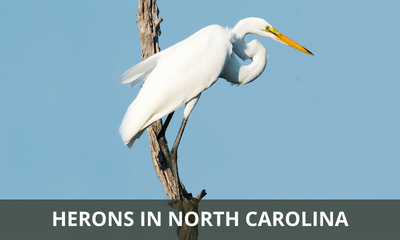
What are the types of herons in North Carolina?
The 12 types of herons found in North Carolina are:
- Great Egret
- Great Blue Heron
- Little Blue Heron
- Snowy Egret
- Cattle Egret
- Green Heron
- Black-crowned Night-heron
- Yellow-crowned Night-Heron
- Tricolored Heron
- American Bittern
- Least Bittern
- Reddish Egret
While many of these herons are year-round residents of North Carolina, others only occur in the state during the winter, as migratory birds that spend the cold months in North Carolina.
Yet other herons are summer visitors during the breeding season, and some are scarce vagrants that are rarely seen in the state (more on that below).
Now let’s dive into the details, and take a closer look at each of these North Carolina herons:
Great Egret
Scientific name: Ardea alba
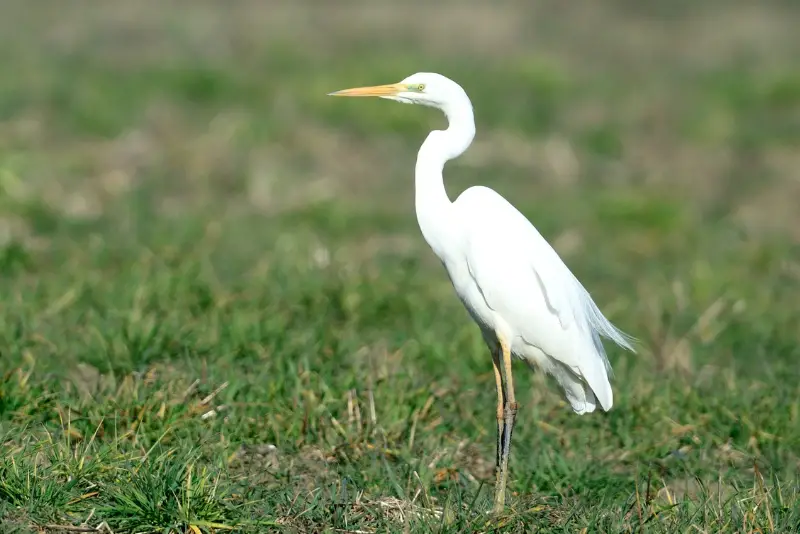
The Great Egret is one of the most common heron species in North Carolina, and outside of the state it has a range that spans nearly the whole planet.
This North Carolina heron species is almost entirely white, except for its long, black legs and yellow beak.
During the spring and summer breeding seasons, the Great Egret grows a long white plume on its back that extends all the way to the tip of its tail.
This majestic long-legged heron lives in both fresh and saltwater habitats, and often nests in large colonies on the shores of marshes, lakes, and rivers.
Great Egrets forage in any type of shallow water, including ponds, lakes, streams, estuaries, as well as rice fields and other flooded areas.
In areas with shallow water, you can observe Great Egrets waiting patiently for their prey before striking with their long beak and spearing it.
Great Egrets build their nests in colonies. Most of the time, they are built high up in trees, often on islands, to keep ground predators from getting to the eggs.
This bird is especially prevalent in coastal regions of North Carolina, where it breeds close to suitable bodies of water during the summer.
Outside of the breeding season it is less common, but where it occurs it can be seen in large flocks.
Great Blue Heron
Scientific name: Ardea herodias
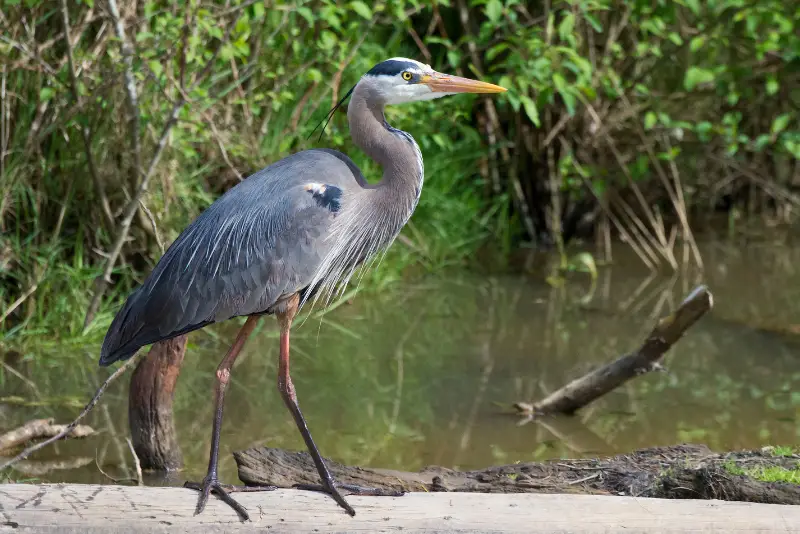
With a wingspan of up to 6 feet, this heron is one of North Carolina’s largest birds. It is almost entirely blue gray, except for a white throat and eye stripe, as well as dark gray wing feathers.
Great Blue Herons can be found in many wetland habitats. You can find them in both saltwater and freshwater marshes, flooded fields, mangrove swamps, and lake shorelines.
This enormous blue bird likes to hunt for small fish by wading in the shallows of estuaries, mud flats and marshes along the seaboard.
This heron can stay motionless in shallow water for a long time, while it waits patiently for a suitably sized fish to come close enough to be grabbed with its long, yellow bill.
The Great Blue Heron is the most common type of heron found in North Carolina
This is one of the most common herons found in the Old North State, where it can be seen year round.
Unfortunately, it is considered a pest at fish hatcheries, since it likes to take advantage of hatcheries to catch more fish than in natural environments.
The Great White Heron is an all-white form of this species, and until recently it was thought that it is a subspecies of the Great Blue Heron.
However, recent evidence suggests that the Great White Herons are actually a separate species.
Fun fact: Old heron nests are sometimes used by owls, as well as other types of birds of prey in North Carolina. These birds appropriate heron nests instead of building their own.
Little Blue Heron
Scientific name: Egretta caerulea
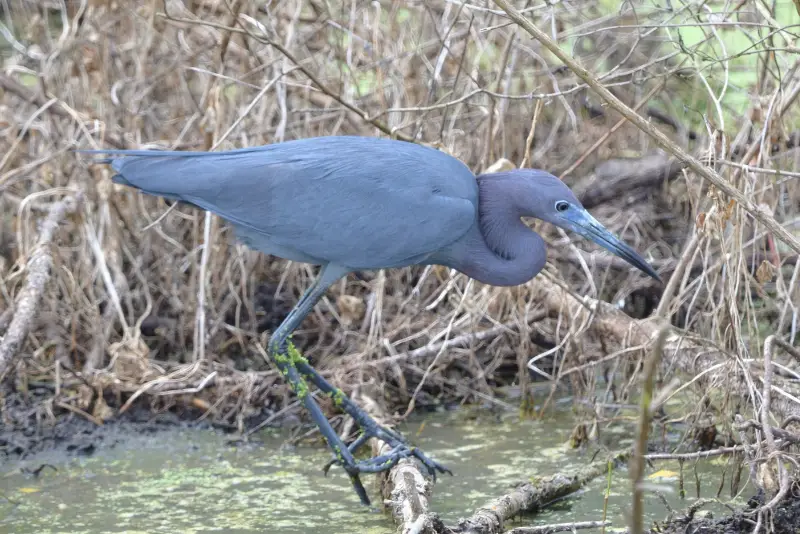
While adult Little Blue Herons are slate blue, young birds are entirely white during their first year.
Juvenile Little Blue Herons can be distinguished from other white herons by their dark bill and green legs.
These small herons are common breeding birds of North Carolina that can be seen year-round.
During winter, their numbers swell, due to an influx of birds from further north, which migrate to North Carolina to spend the winter months.
These herons feed on small fish, mollusks and crustaceans, with crayfish forming a large part of their diet.
They prefer aquatic habitats, where these birds hunt in the shallows, and they are rarely seen away from water.
Little Blue Herons build their nests out of sticks and in colonies. The female lays 4 to 6 eggs, and both parents take turns incubating the eggs for up to 25 days.
Snowy Egret
Scientific name: Egretta thula
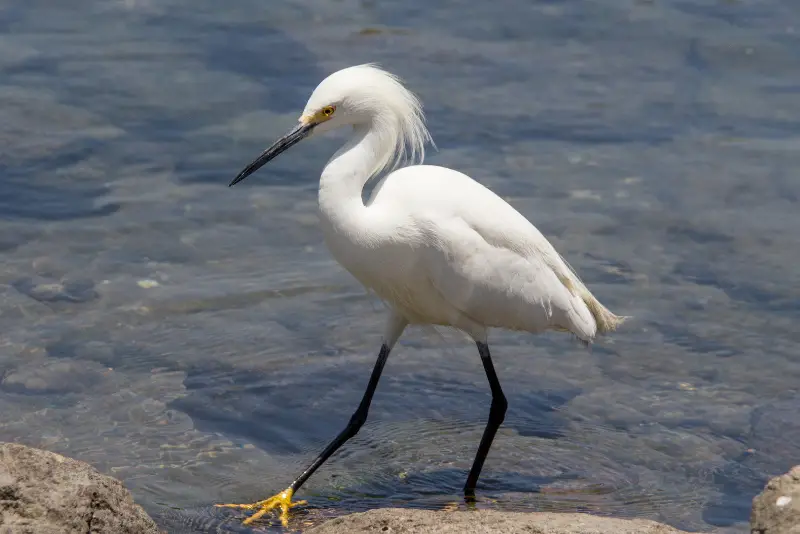
The Snowy Egret is another bird with extensive white plumage that has become an increasingly common breeding bird all over North Carolina.
This is due to aggressive conservation efforts that were necessary because this Egret species was systematically hunted in previous centuries.
This little white heron stands out due to its slim black bill and bright area between the eyes and nostrils.
In adult birds, the legs are totally black, which contrasts with their yellow feet. It is thought that the brightly colored feet help to attract small fish and other prey.
The legs of juvenile birds have a predominant greenish yellow color, with some black areas on the front of the leg.
This bird is found in practically all types of wetland environments, from small ponds to saltwater shorelines and everything in between.
Snowy Egrets feed on fish, crabs, snails, amphibians, and crayfish, which they find in shallow water.
These herons either remain completely still and wait for prey to approach, or they stir up the water with their feet to flush out prey to the surface.
Their nests can be found in trees or hidden among ground-level bushes. The female lays 3 to 6 eggs, which are subsequently incubated by both the male and female.
During the summer, the Snowy Egret is a rare to relatively common breeding bird in North Carolina.
But it is even more common in the state during the winter months, when large numbers can be observed along the coastal areas of North Carolina.
Cattle Egret
Scientific name: Bubulcus ibis
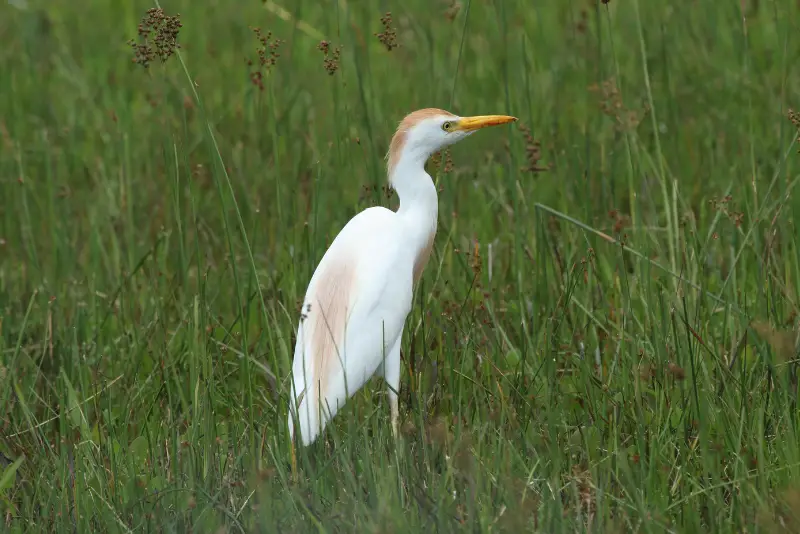
Smaller than Great Egrets, Cattle Egrets have shorter necks and are mostly white with streaks of brownish orange on the head, throat, and back.
The Cattle Egret is a relatively new species in the New World that originated in Europe and Africa.
Nobody knows how these herons crossed the Atlantic, but they were first discovered breeding in Brazil, and later in North Carolina, where these birds first appeared in late 1955.
Cattle Egrets have been very successful at colonizing the Americas, and are common breeding birds all over the southern states.
In contrast to other egrets and herons, Cattle Egrets regularly forage in dry habitats, including high altitude areas.
This is a small egret that is entirely white, except for the breeding season, when adults develop orange plumage on the back of their head, back, and chest.
The legs and the beak are yellow, but at the peak of the breeding season, these herons take on a ruddy hue.
It inhabits a wide range of wetland ecosystems, ranging from shallow saltwater zones to freshwater ponds, swamps, and lakes.
In addition to wetlands, the Cattle Egret also does a significant amount of its foraging in dry areas, such as pastures, where it likes to follow cattle and feed on the insects disturbed by the livestock.
Green Heron
Scientific name: Butorides virescens

The Green Heron is a relatively common water bird in North Carolina. It’s a medium-sized heron with a gray-green body, black wings, and green-black crown.
These herons often live near water, so they’re often seen around lakes, rivers, ponds, or even swimming pools.
These herons eat fish, frogs, snails, small reptiles, amphibians, and crabs and crayfish. They nest in trees or shrubs but sometimes build their nests on islands.
The Green Heron is usually silent except at dusk or dawn, when it makes its characteristic call, which sounds like “kreee.”
Green Herons usually build their nests out of thin twigs, and place them in the crowns of large trees close to water.
However, if suitable nesting trees are not available, they can also nest on the ground, usually underneath a bush.
Black-crowned Night-Heron
Scientific name: Nycticorax nycticorax
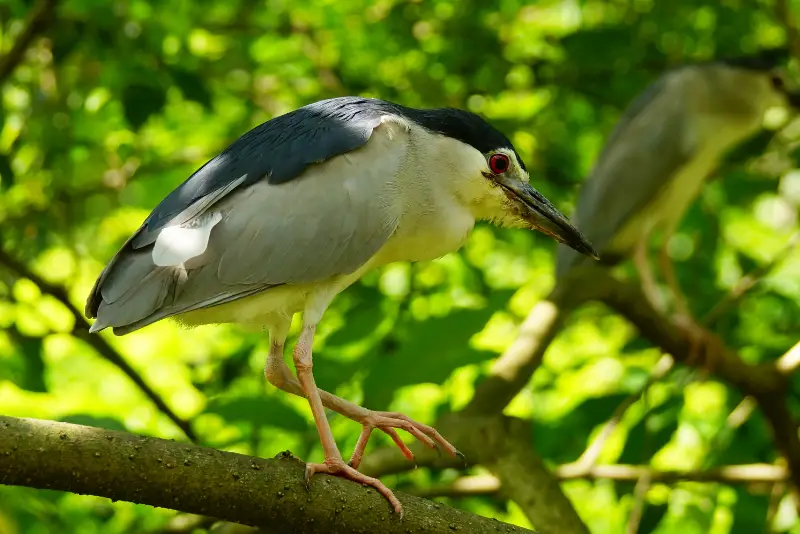
The Black-crowned Night-Heron is true to its name, and is most active at dusk and during the night, when it forages for frogs and small fish in North Carolina wetlands.
These night-herons are common breeding birds and year-round residents in North Carolina, though they can be hard to spot during the day, unless you find their day-time hiding spots.
Another great distinguishing feature of this night bird in North Carolina are its loud squawking bird sounds, which it utters at dusk when it flies out from its roost.
The mating season is marked by a change in appearance of this heron, with the black color of the head and back transforming into a glossy greenish blue.
In addition, the lores become black, while their feet take on a pink or crimson hue.
Black-crowned Night-Herons are social birds that prefer to stay close to each other and nest in colonies sharing the same nesting tree.
Related: The black-colored birds of North Carolina
Yellow-crowned Night-Heron
Scientific name: Nyctanassa violacea
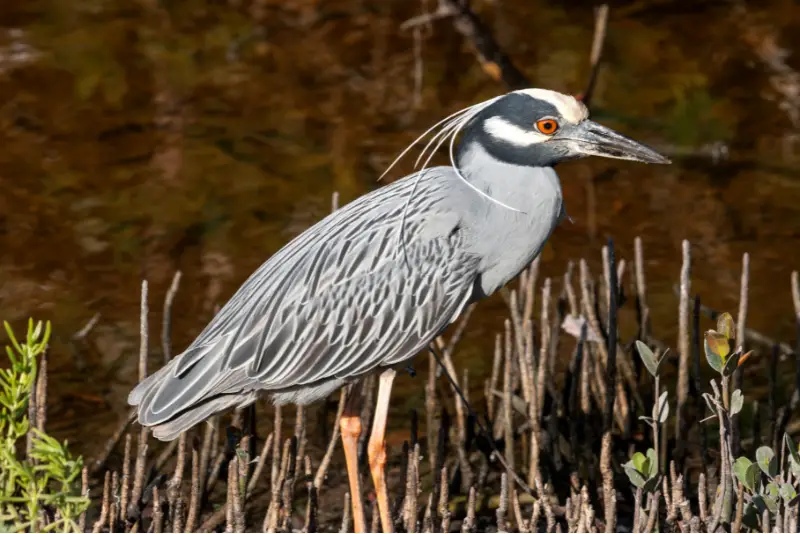
The Yellow-crowned Night-Heron is not quite as nocturnal as its Black-crowned relative, and can be seen foraging both during the day and the night.
These herons are most commonly found along the coast of North Carolina, where they forage for food in shallow water
While crustaceans make up the bulk of the Yellow-crowned Night-Herons’ food, their diet is very varied and also includes small fish, snakes, insects (such as crickets, beetles, grasshoppers and crickets), as well as snails, reptiles, amphibians, and rodents.
Yellow-crowned Night-Herons are summer visitors in inland parts of the Old North State, but are encountered year-round in coastal North Carolina.
Tricolored Heron
Scientific name: Egretta tricolor
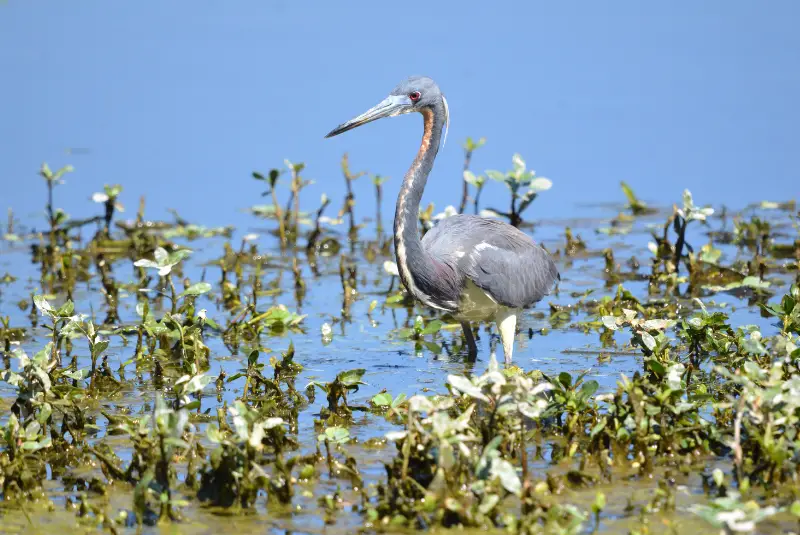
The Tricolored Heron used to be called the Louisiana Heron, and is a medium-sized wading bird with a blue-gray upper side and chest, as well as a white belly.
This heron is a regular breeding bird in the eastern part of North Carolina, where it is most often found in estuaries and salt water marshes along the coast.
While Tricolored Herons like to nest in colonies, sometimes forming colonies with other heron species, they often forage alone and are fiercely protective of their territory.
They consume fish, crustaceans, amphibians, and insects, and will drive away other wading birds that invade their habitat.
This North Carolina shorebird hunts in shallow waters, usually by patiently waiting until its prey comes within reach.
American Bittern
Scientific name: Botaurus lentiginosus

American Bitterns are small members of the heron family that live in marshes and swamps, and are extremely well camouflaged to blend in with aquatic vegetation.
They can blend in with the reeds or cattails surrounding them thanks to their mottled brown patterning, as well as the way they hold their heads pointed upwards while remaining still amid the reeds.
Bitterns have a neck that is similar in length to the rest of their body, which they use to catch small fish and other animals in shallow water.
This heron species is endangered in North Carolina
These small herons are an endangered species in North Carolina. They are summer breeding visitors wherever there are suitable habitats in the state.
Since these water birds are very secretive, the best way to identify a bittern is by its call, which sounds similar to “oonk-ka-oonk.”
American Bitterns eat a wide variety of aquatic organisms, including fish, crabs, insects, frogs, and small mammals.
They wait patiently in the reeds for their prey to approach before making a swift, quiet dash forward to catch it in their bills.
Least Bittern
Scientific name: Ixobrychus exilis

The Least Bittern is hard to spot, since it usually remains hidden in dense reed beds. The best way to identify one of these herons is by its coo-coo-coo call.
If you do get your eyes on a Least Bittern, you’ll be pleasantly surprised by their attractive chestnut orange and black color.
The best places to see these herons are marshes and wetlands with dense vegetation, where they can be observed hunting at the edges of open water.
These bitterns are most active at dawn and at dusk, when they can also be seen flying to and from their roosting trees.
Least Bitterns feed on fish, amphibians, mollusks, lizards, insects, and even rodents.
They forage by grasping individual reeds with their claws while waiting for small aquatic animals to pass by in the water underneath them.
Least Bitterns perch on the reeds and bend their bodies in all sorts of ways to reach their meal floating below.
Reddish Egret
Scientific name: Egretta rufescens
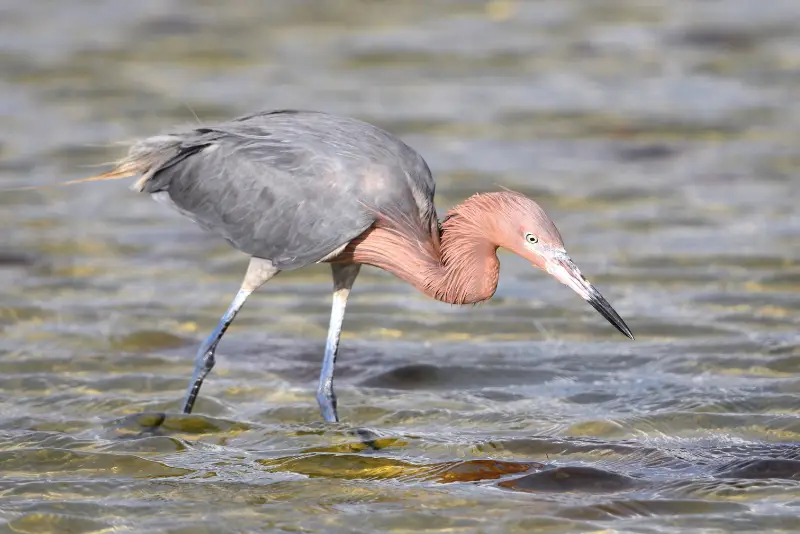
Reddish Egrets are birds of shallow saltwater habitats in coastal areas of the Gulf Coast, and occur in North Carolina as very rare vagrants.
These herons have an unusual foraging tactic when compared to other herons. They hunt for small fish on salt flats at low tide.
But instead of standing motionless and waiting for fish to come within striking distance, Reddish Egrets pursue their prey rapidly on foot, and sometimes wave their wings to startle prey.
They sometimes even take to the air and fly across the water for a short distance, in order to swoop down on their prey.
These small herons have a dark morph and a white morph. The best way to identify them is by their bi-colored bill, which is yellow at the base, and black at the tip.
The dark morph of the Reddish Egret that has a bluish-gray body and a cinnamon-colored head, throat, and breasts.
Conclusion
And there we have the herons found in the state of North Carolina.
The varied habitats of North Carolina are home to more than 400 different species of birds, and herons make up a significant proportion of this rich avifauna.
Ranging from herons to egrets and bitterns, these birds play a vital role in the ecology of their habitats.
If you enjoyed this article, check out our guide to the common birds of North Carolina.

